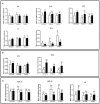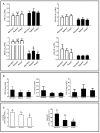Inducing the Alternative Oxidase Forms Part of the Molecular Strategy of Anoxic Survival in Freshwater Bivalves
- PMID: 29527172
- PMCID: PMC5829090
- DOI: 10.3389/fphys.2018.00100
Inducing the Alternative Oxidase Forms Part of the Molecular Strategy of Anoxic Survival in Freshwater Bivalves
Erratum in
-
Corrigendum: Inducing the Alternative Oxidase Forms Part of the Molecular Strategy of Anoxic Survival in Freshwater Bivalves.Front Physiol. 2018 Mar 27;9:330. doi: 10.3389/fphys.2018.00330. eCollection 2018. Front Physiol. 2018. PMID: 29634042 Free PMC article.
Abstract
Hypoxia in freshwater ecosystems is spreading as a consequence of global change, including pollution and eutrophication. In the Patagonian Andes, a decline in precipitation causes reduced lake water volumes and stagnant conditions that limit oxygen transport and exacerbate hypoxia below the upper mixed layer. We analyzed the molecular and biochemical response of the North Patagonian bivalve Diplodon chilensis after 10 days of experimental anoxia (<0.2 mg O2/L), hypoxia (2 mg O2/L), and normoxia (9 mg O2/L). Specifically, we investigated the expression of an alternative oxidase (AOX) pathway assumed to shortcut the regular mitochondrial electron transport system (ETS) during metabolic rate depression (MRD) in hypoxia-tolerant invertebrates. Whereas, the AOX system was strongly upregulated during anoxia in gills, ETS activities and energy mobilization decreased [less transcription of glycogen phosphorylase (GlyP) and succinate dehydrogenase (SDH) in gills and mantle]. Accumulation of succinate and induction of malate dehydrogenase (MDH) activity could indicate activation of anaerobic mitochondrial pathways to support anoxic survival in D. chilensis. Oxidative stress [protein carbonylation, glutathione peroxidase (GPx) expression] and apoptotic intensity (caspase 3/7 activity) decreased, whereas an unfolded protein response (HSP90) was induced under anoxia. This is the first clear evidence of the concerted regulation of the AOX and ETS genes in a hypoxia-tolerant freshwater bivalve and yet another example that exposure to hypoxia and anoxia is not necessarily accompanied by oxidative stress in hypoxia-tolerant mollusks.
Keywords: Diplodon chilensis; alternative oxidase; anaerobiosis; hypoxia; mitochondrial electron transport; oxidative stress.
Figures



References
-
- Abele D., Brey T., Philipp E. (2017). Treatise Online no. 92: Part N, Revised, Volume 1, Chapter 7: Ecophysiology of Extant Marine Bivalvia. Paleontological Institute, University of Kansas, Lindley Hall.
-
- Anestis A., Pörtner H., Michaelidis B. (2010). Anaerobic metabolic patterns related to stress responses in hypoxia exposed mussels Mytilus galloprovincialis. J. Exp. Mar. Biol. Ecol. 394, 123–133. 10.1016/j.jembe.2010.08.008 - DOI
-
- Balzarini M., Gonzalez L., Tablada M., Casanoves F., Di Rienzo J., Robledo C. (2008). InfoStat, in Manual del Usuario, ed Brujas (Córdoba: ), 1–334.
LinkOut - more resources
Full Text Sources
Other Literature Sources
Research Materials

